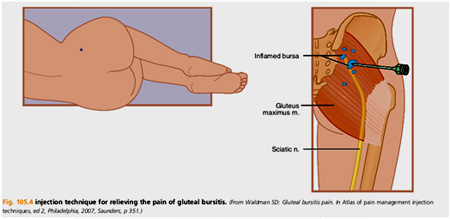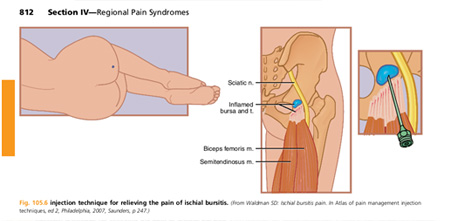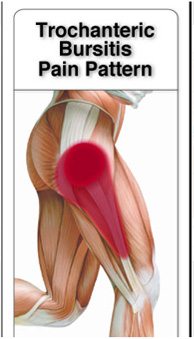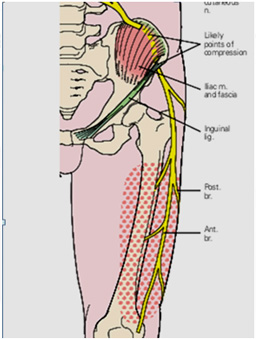 Gluteal bursitis
Gluteal bursitis
The gluteal bursae lie between the gluteus maximus and medius and minimus muscles as well as between these muscles and the underlying bone.
A patient suffering from gluteal bursitis frequently complains of pain at the upper outer quadrant of the buttock.
Physical examination of patients suffering from gluteal bursitis may reveal point tenderness in the upper outer quadrant of the buttocks.
 Ischiogluteal Bursitis
Ischiogluteal Bursitis
The ischial bursa lies between the gluteus maximus muscle and the bone of the ischial tuberosity.
A patient suffering from ischial bursitis frequently complains of pain at the base of the buttock during resisted extension of the lower extremity. The pain is localized to the area over the ischial tuberosity, with referred pain noted into the hamstring muscle.
Physical examination may reveal point tenderness over the ischial tuberosity. Passive straight-leg raising and active resisted extension of the affected lower extremity reproduce the pain.
 Trochanteric Bursitis
Trochanteric Bursitis
Trochanteric bursitis is a common painful condition caused by the irritation or inflammation of the trochanteric bursa.
Patients with trochanteric bursitis generally present with chronic intermittent aching pain over the lateral aspect of the affected hip. Pain is worsened by sitting in a deep chair or car seat, bicycling, golfing, climbing stairs, or lying on the affected side. The condition also occurs as a result of a running injury, most commonly in female athletes with a wide pelvis.
The most consistent physical finding in patients with trochanteric bursitis is localized tenderness over the greater trochanter, usually on the posterosuperior aspect over the tendinous insertion of the gluteus medius
 Iliopsoas Bursitis
Iliopsoas Bursitis
Patients present with pain in the inguinal or hip regions, and this the pain often radiates to the anterior thigh. Aggravating activities include walking up stairs, putting on shoes and socks, and moving from a sitting to a standing position. Some patients may also describe abdominal pain.
Meralgia Paresthetica
 Meralgia paresthetica is caused by compression of the lateral femoral cutaneous nerve by the inguinal ligament as it passes through or under the inguinal ligament. This entrapment neuropathy manifests as pain, numbness, and dysesthesias in the distribution of the lateral femoral cutaneous nerve. These symptoms often begin as a burning pain in the lateral thigh with associated cutaneous sensitivity. Patients suffering from meralgia paresthetica note that sitting, squatting, and wearing wide belts or low- rider trousers that compress the lateral femoral cutaneous nerve cause their symptoms to worsen
Meralgia paresthetica is caused by compression of the lateral femoral cutaneous nerve by the inguinal ligament as it passes through or under the inguinal ligament. This entrapment neuropathy manifests as pain, numbness, and dysesthesias in the distribution of the lateral femoral cutaneous nerve. These symptoms often begin as a burning pain in the lateral thigh with associated cutaneous sensitivity. Patients suffering from meralgia paresthetica note that sitting, squatting, and wearing wide belts or low- rider trousers that compress the lateral femoral cutaneous nerve cause their symptoms to worsen
Physical findings include tenderness over the lateral femoral cutaneous nerve at the origin of the inguinal ligament at the anterior superior iliac spine
Injection for lateral femoral cutaneous nerve
